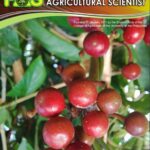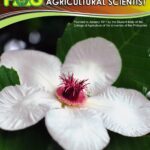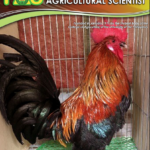Vol. 104, No. 4 (Dec 2021)
Labeled as a high value export niche for the country, the continuous demand for P. monodon requires an increasing supply of the shrimp. The aquaculture sectors have provided measures and techniques in shrimp farming and rearing processes to improve the production of stocks. The Philippines was a top marine product exporter in the previous decades, reaching its peak in 1992 with earnings of approximately 300 million USD (FAO 2005). However, despite the high earnings and production of P. monodon in the previous decades, there was a significant decrease in its production in the country starting in the mid-1990s, which posed a threat to the shrimp industry. Pathogenic diseases have been known to be the major cause of the decrease in shrimp production, effecting a huge economic loss. (https://doi.org/10.62550/RI21121044)
Categories
Articles
First Detection of Naturally Introgressed BT Cry1Ab in Asian Corn Borer *Ostrinia furnacalis (Guenée)+-Resistant Traditional Maize (Silangan) in the Philippines
Merdelyn T. Caasi-Lit, Eureka Teresa M. Ocampo, Artemio M. Salazar, Jefferson F. Paril, Bryan V. Novio, Bernard B. Panabang, and Angelyn Marta D. Marmeto
Received: November 12, 2019/ Revised: October 09, 2021/ Accepted: November 08, 2021 (https://doi.org/10.62550/KT11124019)
Resistance against insect pests is one of the most promising and highly favored characteristics of an economically important crop. In the Philippines, the Asian corn borer (ACB), Ostrinia furnacalis (Guenée), is the most destructive insect pest of maize. The discovery of Bacillus thuringiensis and the Bt toxin, which led to the development of Bt corn, effectively controlled this pest. In this study, four traditional varieties of maize that showed resistance against ACB were tested for the presence of Bt Cry1Ab protein. Out of these four, a traditional variety from San Carlos City, Pangasinan, which was initially thought to have natural resistance against the pest, tested positive for the ...
Resistance against insect pests is one of the most promising and highly favored characteristics of an economically important crop. In the Philippines, the Asian corn borer (ACB), Ostrinia furnacalis (Guenée), is the most destructive insect pest of maize. The discovery of Bacillus thuringiensis and the Bt toxin, which led to the development of Bt corn, effectively controlled this pest. In this study, four traditional varieties of maize that showed resistance against ACB were tested for the pre...
Climatic Factors Affecting Maize Grain Yield in Different Growing Areas of The Philippines
Lakshman Kumara P.G.A, Tonette P. Laude, Jose E. Hernandez, Pearl B. Sanchez, Moises A. Dorado, Jose Nestor M. Garcia, Gerardo B. Gauna, and Pompe C. Sta. Cruz
Received: August 26, 2021/ Revised: December 10, 2021/ Accepted: December 16, 2021 (https://doi.org/10.62550/HF26100021)
Seasonal climate variation is one of the problems faced by Filipino maize farmers, due to varying climatic elements such as solar radiation, rainfall, relative humidity, and air temperature. This study determined the seasonal productivity of selected maize varieties in the major growing areas in the Philippines, and identified the yield-limiting climatic factors specific to location and growing season. Grain yield, covering two wet and dry seasons (2016-2018) from seven field trials (representing 3 climatic types) of the National Corn Testing (NCT) were used in the study. Climatic data (2016-2018) were gathered from the PAGASA weather station nearest to the trial site. Significant variati...
Seasonal climate variation is one of the problems faced by Filipino maize farmers, due to varying climatic elements such as solar radiation, rainfall, relative humidity, and air temperature. This study determined the seasonal productivity of selected maize varieties in the major growing areas in the Philippines, and identified the yield-limiting climatic factors specific to location and growing season. Grain yield, covering two wet and dry seasons (2016-2018) from seven field trials (represen...
Establishment of the In Vitro Culture and Plant Regeneration of Anubias barteri var. nana 'Mini'
Kuan-Hung Lin, Chih-Peng Kuo, and Li-Ru Chen
Received: July 30, 2020/ Revised: November 18, 2021/ Accepted: November 21, 2021 (https://doi.org/10.62550/GB30058020)
Anubias barteri is an ornamental aquatic plant of economic importance worldwide. Effective removal of contaminants has been a major problem for the in vitro propagation of A. barteri. Hydrogen peroxide (H2O2) was applied as a pre-disinfectant to treat rhizome bud explants of A. barteri var. nana ‘Mini’ followed by disinfection with mercuric chloride (HgCl2) to eliminate in vitro contamination. However, application of 0.1% HgCl2 for 5 min without pre-disinfecting with H2O2 significantly reduced the contamination rate to 44.4% compared to other combinations. Moreover, in vitro shoots of A. barteri var. nana ‘Mini’ were used as plant materials for determining the basal requirement of inorgan...
Anubias barteri is an ornamental aquatic plant of economic importance worldwide. Effective removal of contaminants has been a major problem for the in vitro propagation of A. barteri. Hydrogen peroxide (H2O2) was applied as a pre-disinfectant to treat rhizome bud explants of A. barteri var. nana ‘Mini’ followed by disinfection with mercuric chloride (HgCl2) to eliminate in vitro contamination. However, application of 0.1% HgCl2 for 5 min without pre-disinfecting with H2O2 significantly reduce...
Serine/Threonine Protein Phosphatase 1-α (STPP1-α) from Black Tiger Shrimp, Penaeus monodon, an Immune-Related Gene
Jacqueline Marjorie R. Pereda, Neil Andrew D. Bascos, and Mudjekeewis D. Santos 371
Received: June 14, 2021/ Revised: October 02, 2021/ Accepted: November 17, 2021 (https://doi.org/10.62550/FR14067021)
Reversible protein phosphorylation is a significant regulatory mechanism in many cellular functions, such as the dephosphorylation of Serine/Threonine protein residues catalyzed by protein phosphatase. In this study, the full-length STPP1-α gene from Penaeus monodon was cloned, characterized, and analyzed for its constitutive expression in WSSV-negative P. monodon organs. The gene was originally an isotig isolated from the gills of P. monodon that survived WSSV infection. PmSTPP1-α gene (GenBank: KX385833) has a total of 2,171 bp, with a 990 open reading frame (ORF) that encodes 329 amino acids (aa), sharing a 93% sequence identity with human Serine/Threonine PP1-α catalytic subunit. The ...
Reversible protein phosphorylation is a significant regulatory mechanism in many cellular functions, such as the dephosphorylation of Serine/Threonine protein residues catalyzed by protein phosphatase. In this study, the full-length STPP1-α gene from Penaeus monodon was cloned, characterized, and analyzed for its constitutive expression in WSSV-negative P. monodon organs. The gene was originally an isotig isolated from the gills of P. monodon that survived WSSV infection. PmSTPP1-α gene (GenB...
Rearing Silver Therapon Leiopotherapon plumbeus (Teleostei: Terapontidae) Larvae Using Euryhaline Rotifers as Starter Food
Frolan A. Aya, Vicar Stella N. Nillasca, and Luis Maria B. Garcia
Received: January 20, 2021/ Revised: October 11, 2021/ Accepted: November 29, 2021 (https://doi.org/10.62550/AL20010021)
The silver therapon Leiopotherapon plumbeus is an important but dwindling freshwater food commodity in the Philippine freshwater habitats. The influence of feeding regimes on growth performance and survival of first-feeding silver therapon larvae fed euryhaline rotifers (Brachionus rotundiformis and B. plicatilis) as starter food was examined. Larvae at 2 days post-hatch (DPH) (1.93 ± 0.07 mm; 200 larvae/basin) were initially reared on rotifers for 12 days followed by Artemia nauplii from 14 to 35 DPH as follows: (A) B. rotundiformis from 2-13 DPH; (B) B. rotundiformis from 2-7 DPH and Moina micrura from 8-13 DPH; and (C) B. plicatilis from 2-13 DPH. After 35 days of rearing, mean surviva...
The silver therapon Leiopotherapon plumbeus is an important but dwindling freshwater food commodity in the Philippine freshwater habitats. The influence of feeding regimes on growth performance and survival of first-feeding silver therapon larvae fed euryhaline rotifers (Brachionus rotundiformis and B. plicatilis) as starter food was examined. Larvae at 2 days post-hatch (DPH) (1.93 ± 0.07 mm; 200 larvae/basin) were initially reared on rotifers for 12 days followed by Artemia nauplii from 14 ...


